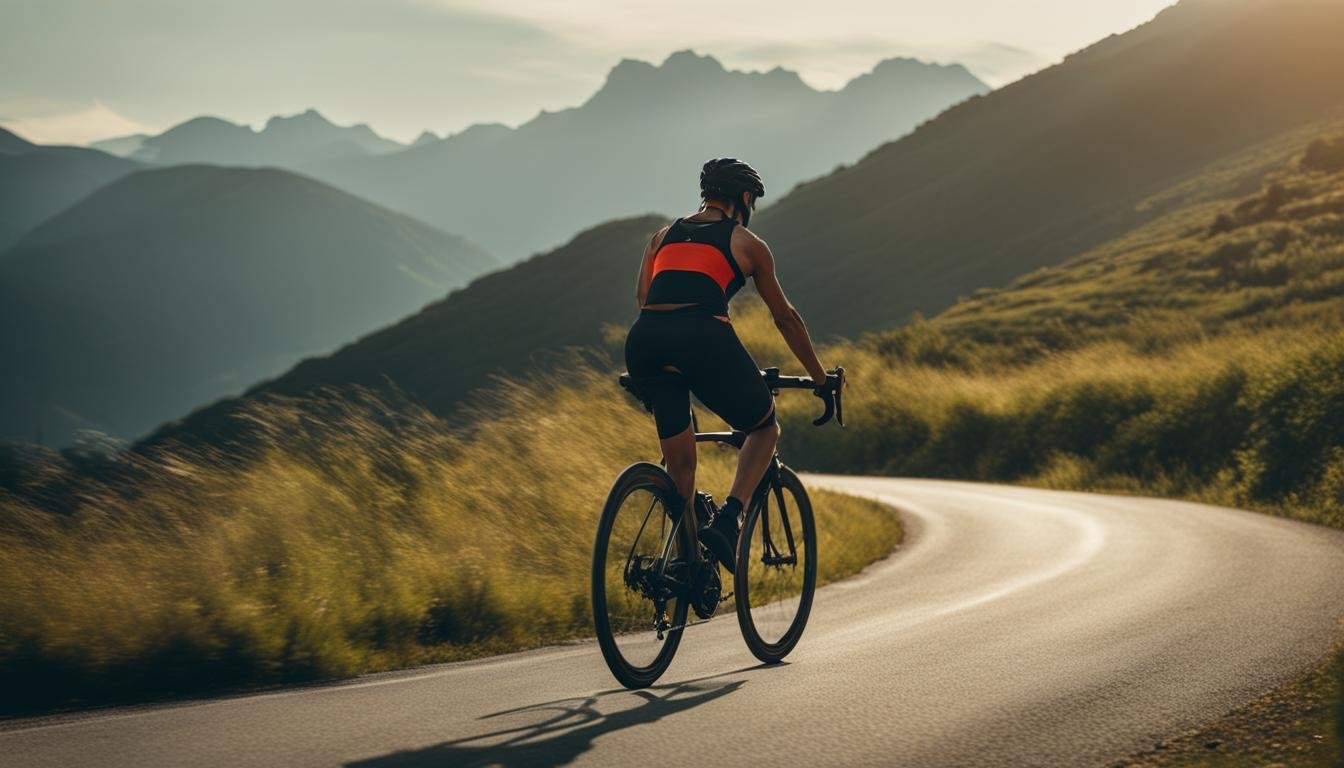Biking After Leg Day: Enhance Your Recovery
Are you looking for ways to enhance your post-leg day recovery? Biking might just be the answer you’ve been searching for. By hopping on a bike after an intense leg workout, you can reap numerous benefits that will help your muscles recover faster and improve your overall fitness. Discover how biking after leg day can be a game-changer for your recovery process.
Key Takeaways:
- Biking after a leg day workout can enhance your recovery process.
- It increases blood flow to your legs, aiding in muscle development and endurance.
- Cycling after leg day can help reduce muscle soreness.
- Gradually increase the intensity and duration of your cycling workouts over time.
- Don’t forget to prioritize proper warm-up techniques and listen to your body.
Is Cycling After Leg Day A Good Idea?
Cycling after a leg day workout is generally a good idea. It can provide numerous benefits to aid in your recovery process and overall fitness. By increasing blood flow to the legs, cycling helps deliver oxygen and nutrients to the muscles, promoting healing and reducing muscle soreness. It also helps improve cardiovascular fitness and endurance, which are essential for optimal performance in cycling.
While it is generally okay to bike after leg day, it’s important to listen to your body and make adjustments as needed. If you’re experiencing excessive muscle soreness or fatigue, it may be a sign that your legs need more time to recover. In such cases, consider reducing the intensity or duration of your ride or opting for a low-impact form of exercise, such as light walking or stretching.
“Maintaining a balance between pushing yourself and allowing your body to recover is key.”
Remember to warm up properly before cycling to prepare your muscles for the workout and prevent injury. Start with a slower pace and gradually increase the intensity as your muscles loosen up. It’s also important to stretch your muscles before and after your ride to promote flexibility and minimize the risk of post-exercise stiffness.
Listen to Your Body and Adjust Accordingly
Keep in mind that everyone’s body is different, and what works for one person may not work for another. Pay attention to any signs of pain, discomfort, or overexertion during or after your ride. If you experience any of these symptoms, it’s crucial to give your body the rest it needs and consult with a healthcare professional if necessary.
Overall, cycling after a leg day workout can be a beneficial addition to your recovery routine. It aids in blood flow, reduces muscle soreness, and improves cardiovascular fitness. By following proper warm-up techniques, listening to your body, and gradually increasing the intensity and duration of your cycling workouts, you can maximize the benefits and enhance your overall fitness.
11 Things to Consider If You’re Going to Cycle After Leg Day
Cycling after a leg day workout can be a great way to enhance your recovery and improve your overall fitness. However, there are several things you should consider to ensure a safe and effective cycling session:
- Warm-up: Start with a proper warm-up to prepare your muscles for the workout and prevent injury. A few minutes of light stretching or a short walk can do wonders.
- Start Slow: Pedal slowly and steadily on a stationary bike for about 20 minutes to condition your muscles without exerting too much energy.
- Incorporate Interval Training: Interval training can help increase your cardiovascular fitness and endurance. Alternate between high-intensity bursts and lower-intensity recovery periods during your ride.
- Focus on Form: Pay attention to your form while cycling. Maintain proper posture, engage your core, and pedal with a smooth and controlled motion.
- Stretch or Roll: After your cycling session, take the time to stretch or use a foam roller to roll out your leg muscles. This can help alleviate any tightness or soreness.
- Gradually Increase Intensity: As your muscles adapt and recover, gradually increase the intensity and duration of your cycling workouts. Push yourself, but listen to your body and avoid overexertion.
- Fuel Your Body: After your ride, refuel your body with a protein-rich meal to aid in muscle recovery and repair.
- Stay Hydrated: Drink plenty of water throughout the day to stay hydrated and support optimal muscle function.
- Pre-Ride Stretching: Before starting your cycling session, perform a few dynamic stretches to warm up your leg muscles and increase flexibility.
- Listen to Your Body: Pay attention to any signs of pain or discomfort during your ride. If something doesn’t feel right, adjust your intensity or take a break.
- Rest and Recover: Allow your body enough time to rest and recover between leg day workouts and cycling sessions. Rest is just as important as exercise for optimal performance.
By following these guidelines, you can make the most out of your post-leg day cycling routine while minimizing the risk of injury and maximizing your recovery benefits.
Why and How Long You Should Cycle After Leg Day
After a challenging leg day workout, you may be wondering if cycling is a good idea for your recovery. The answer is yes, but understanding why and how long you should cycle after leg day is essential for maximizing the benefits and avoiding potential risks.
The Purpose of Cycling After Leg Day
The primary goal of cycling after leg day is to promote blood flow to your muscles. When you engage in intense leg exercises, such as squats and lunges, your muscles experience micro-tears. Cycling helps increase blood circulation, delivering oxygen and nutrients to these muscles, which aids in the recovery process. This blood flow also helps reduce muscle soreness, allowing you to bounce back faster and get back to training.
Duration of Your Cycling Session
The length of your cycling session after a leg day workout will depend on factors such as the intensity of your leg workout and your current fitness level. As a general guideline, starting with a 20-30 minute session at a moderate intensity is recommended. This duration allows your muscles to receive the benefits of increased blood flow without overexerting them. Over time, as your muscles recover and adapt, you can gradually increase the duration of your cycling sessions to further enhance your recovery and fitness.
Listen to Your Body
While it is important to have a guideline for the duration of your cycling session, it is equally crucial to listen to your body. Pay attention to any signs of pain or discomfort during your ride. If you feel any strain or excessive fatigue in your leg muscles, it is a signal to reduce the intensity or duration of your cycling session. Prioritize gentle, low-impact pedaling to aid in recovery rather than pushing yourself to the limits. Remember, the purpose of cycling after leg day is to support your muscles’ recovery, not to exhaust them further.
| Benefits of Cycling After Leg Day |
|---|
| Promotes blood flow to the muscles |
| Reduces muscle soreness |
| Aids in muscle recovery and development |
| Improves cardiovascular fitness and endurance |
The Best Leg Exercises for Cyclists
If you’re a cyclist looking to improve your performance, incorporating specific leg exercises into your training routine can be highly beneficial. These exercises target key muscle groups involved in cycling, helping to strengthen and stabilize your legs for better power and endurance on the bike.
Here are some of the best leg exercises for cyclists:
- Squats: This compound exercise targets the quadriceps, hamstrings, and glutes. It helps build lower body strength and power, which are crucial for generating force when pedaling.
- Deadlifts: Deadlifts primarily work the hamstrings and glutes, but they also engage the lower back and core muscles. They help improve overall posterior chain strength, which contributes to better cycling performance.
- Lunges: Lunges are great for targeting the quadriceps, hamstrings, and glutes. They also help improve balance and stability, which can translate to better bike control.
- Leg Press: The leg press machine allows you to focus on the leg muscles without placing stress on the lower back. It primarily targets the quadriceps, hamstrings, and glutes, providing an effective lower body workout.
- Calf Raises: Strong calf muscles are essential for generating power during the pedal stroke. Calf raises help strengthen the calf muscles, improving pedal efficiency and reducing the risk of injuries such as Achilles tendonitis.
By incorporating these exercises into your training routine, you can enhance your leg strength, power, and stability, ultimately improving your performance on the bike. Remember to start with lighter weights and gradually increase the intensity as your muscles adapt and get stronger. It’s also important to maintain proper form and technique to maximize the benefits of each exercise.
| Exercise | Muscles Targeted |
|---|---|
| Squats | Quadriceps, Hamstrings, Glutes |
| Deadlifts | Hamstrings, Glutes, Lower Back, Core |
| Lunges | Quadriceps, Hamstrings, Glutes |
| Leg Press | Quadriceps, Hamstrings, Glutes |
| Calf Raises | Calf Muscles |
Benefits of Cycling After Leg Day
After a challenging leg day workout, hopping on a bike for a cycling session can offer you several benefits. Biking after leg day enhances your recovery and aids in muscle development. It also improves your muscle endurance and cardiovascular fitness, making it an excellent addition to your fitness routine.
One of the key advantages of cycling after leg day is increased blood flow to your muscles. As you pedal, your legs receive a steady supply of oxygen and nutrients, which helps reduce muscle soreness and promotes faster recovery. This increased blood flow also stimulates muscle growth and can improve overall muscle mass.
In addition to these recovery benefits, cycling after leg day contributes to improved cardiovascular fitness. The sustained pedaling motion elevates your heart rate, boosting your endurance and strengthening your cardiovascular system. This can have positive effects on your overall health and well-being.
Furthermore, cycling after leg day can aid in weight loss. The calorie-burning nature of cycling, coupled with the afterburn effect (continued calorie burn post-workout), can help you shed excess pounds and maintain a healthy weight. Incorporating cycling into your leg day recovery routine can be an effective way to enhance your fitness goals.
Conclusion
Biking after a leg day workout can be a beneficial addition to your recovery routine. It helps improve blood flow, reduces muscle soreness, and promotes muscle development and endurance. By following proper warm-up techniques, gradually increasing the duration of your cycling sessions, and listening to your body, you can maximize the benefits of biking after leg day.
Include leg exercises in your training routine to strengthen key muscle groups for cycling. Squats, deadlifts, lunges, leg press, and calf raises are great exercises to incorporate. These exercises will not only enhance your cycling power and stability but also help prevent injuries.
Remember to prioritize recovery and fuel your body properly after your ride. Make sure to have a protein-rich meal to aid in muscle repair and growth. Stay hydrated throughout the day to support overall performance and recovery.
FAQ
Is it okay to do cycling after leg day?
Yes, cycling after a leg day workout can be beneficial for your recovery process.
Is it okay to bike after lifting?
Yes, biking after a leg day workout can help improve blood flow, reduce muscle soreness, and promote muscle development.
Is it okay to bike with sore legs?
It is generally okay to bike with sore legs, but you should listen to your body and adjust the intensity or duration of the ride as needed.
What should I consider if I’m going to cycle after leg day?
Some things to consider include starting with a proper warm-up, incorporating interval training, focusing on proper form, and stretching or rolling your muscles for recovery.
Why and how long should I cycle after leg day?
Cycling after leg day helps increase blood flow, reduce muscle soreness, and improve cardiovascular fitness. The length of your cycling session depends on the intensity of your workout and your current fitness level.
What are the best leg exercises for cyclists?
Squats, deadlifts, lunges, leg press, and calf raises are some of the best leg exercises for cyclists as they strengthen key muscle groups for cycling power and stability.
What are the benefits of cycling after leg day?
Cycling after leg day increases blood flow, aids in muscle recovery, improves muscle endurance, and can aid in weight loss due to increased calorie burning.







